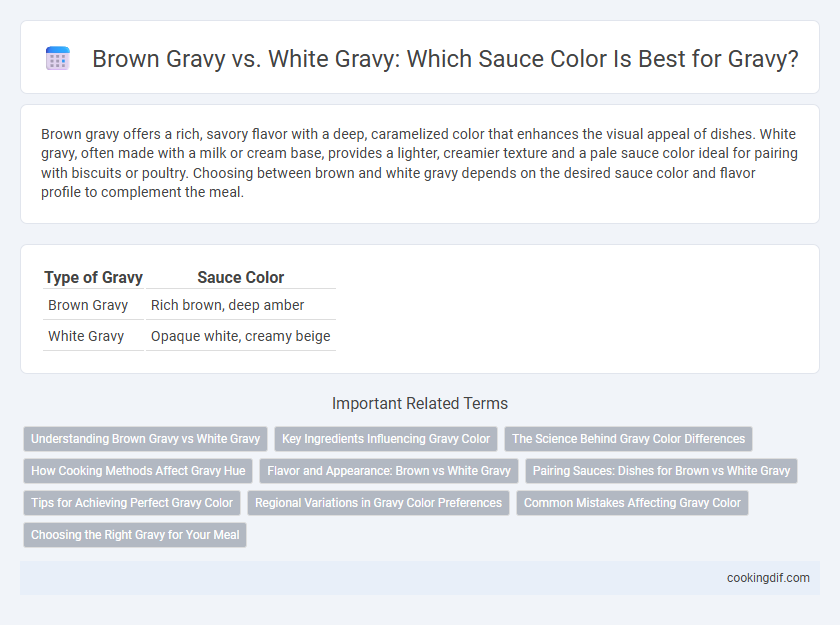Brown gravy offers a rich, savory flavor with a deep, caramelized color that enhances the visual appeal of dishes. White gravy, often made with a milk or cream base, provides a lighter, creamier texture and a pale sauce color ideal for pairing with biscuits or poultry. Choosing between brown and white gravy depends on the desired sauce color and flavor profile to complement the meal.
Table of Comparison
| Type of Gravy | Sauce Color |
|---|---|
| Brown Gravy | Rich brown, deep amber |
| White Gravy | Opaque white, creamy beige |
Understanding Brown Gravy vs White Gravy
Brown gravy, made from beef or veal drippings combined with browned flour and broth, offers a rich, deep color and robust flavor ideal for meats like roast beef and mashed potatoes. White gravy, often prepared from pan drippings, milk, and flour, delivers a creamy texture and pale appearance, commonly paired with biscuits, fried chicken, or country-fried steak. The choice between brown and white gravy influences both the visual appeal and taste profile of dishes, emphasizing savory depth in brown gravy versus mild creaminess in white gravy.
Key Ingredients Influencing Gravy Color
Brown gravy's rich color primarily results from browned meat drippings and caramelized onions, which create a deep, savory base. White gravy, often called country gravy, uses milk or cream as its main liquid combined with flour and fat, resulting in a creamy, pale appearance. The Maillard reaction in brown gravy contrasts with the lighter, dairy-based ingredients in white gravy, highlighting key ingredient differences that influence sauce color.
The Science Behind Gravy Color Differences
Brown gravy's deep color results from the Maillard reaction, where amino acids and reducing sugars in browned meat drippings create complex pigments called melanoidins. White gravy derives its pale hue from a roux of butter and flour cooked without browning, with milk or cream added, preventing Maillard browning and maintaining its light color. The chemical reactions during roux preparation fundamentally determine the sauce's color, flavor, and texture profiles.
How Cooking Methods Affect Gravy Hue
Brown gravy develops its rich, deep color through the Maillard reaction during the browning of meat drippings and flour, enhancing both flavor and hue. White gravy, often called cream gravy or country gravy, achieves its light color by cooking flour with milk or cream without browning, preserving a pale, creamy appearance. Cooking methods such as roasting or searing contribute to darker gravy tones, while gentle simmering with dairy maintains a lighter, white gravy shade.
Flavor and Appearance: Brown vs White Gravy
Brown gravy offers a rich, savory flavor with deep umami notes derived from roasted meat drippings and caramelized browning, resulting in a darker, glossy sauce that enhances hearty dishes. White gravy features a creamy, milder taste made from milk, butter, and flour, presenting a smooth, pale appearance that complements comfort foods like biscuits and fried chicken. The contrast in both flavor intensity and color makes brown gravy ideal for robust meals, while white gravy suits lighter, cream-based dishes.
Pairing Sauces: Dishes for Brown vs White Gravy
Brown gravy, rich and robust, pairs perfectly with red meats like roast beef, meatloaf, and mashed potatoes, enhancing the hearty flavors of these dishes. White gravy, creamy and mild, complements southern classics such as biscuits and sausage, fried chicken, and mashed potatoes, adding a smooth texture and subtle seasoning. Choosing between brown and white gravy depends on the flavor profile of the main dish, with brown gravy suiting savory, smoky meals and white gravy ideal for creamy, comfort food recipes.
Tips for Achieving Perfect Gravy Color
To achieve the perfect brown gravy color, use roasted pan drippings and cook the roux until it reaches a deep caramel hue, enhancing both flavor and appearance. For white gravy, start with a light blonde roux and gradually add milk or cream, stirring constantly to keep the color pale and smooth without browning. Control heat carefully during cooking to prevent burning and adjust consistency for the desired sauce thickness.
Regional Variations in Gravy Color Preferences
Brown gravy, typically made from beef or turkey drippings, is favored in the Northeastern and Midwestern United States for its rich, savory flavor and deep color, complementing meats like roast beef and mashed potatoes. White gravy, often a milk-based sauce thickened with flour and sausage drippings, is popular in the Southern United States, especially in states like Tennessee and Texas, where it is commonly served over biscuits or fried chicken. These regional variations in gravy color reflect traditional Southern comfort food origins versus the hearty, meat-centric dishes prevalent in the North and Midwest.
Common Mistakes Affecting Gravy Color
Common mistakes affecting gravy color include using overly browned roux for white gravy, which results in an unintended dark hue, and insufficiently cooked drippings for brown gravy, causing a pale or washed-out appearance. Overheating or burning the roux can darken white gravy beyond the desired creamy tone, while undercooking flour in brown gravy yields a raw, floury taste and uneven color. Using improper fat types or adding milk too early can also alter the distinct coloration between brown and white gravies.
Choosing the Right Gravy for Your Meal
Brown gravy, made from beef or poultry drippings, offers a rich, robust flavor perfect for hearty dishes like roasted meats and mashed potatoes. White gravy, typically made from a milk-based roux, provides a creamy, mild taste that complements comfort foods such as biscuits and fried chicken. Selecting the right gravy depends on the meal's flavor profile and desired sauce color to enhance overall presentation and taste.
Brown Gravy vs White Gravy for sauce color Infographic

 cookingdif.com
cookingdif.com